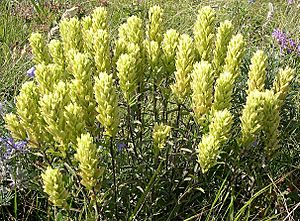Castilleja occidentalis facts for kids
Quick facts for kids Castilleja occidentalis |
|
|---|---|
 |
|
| Conservation status | |
| Scientific classification | |
| Genus: |
Castilleja
|
| Species: |
occidentalis
|
The Castilleja occidentalis, also known as the Western Indian Paintbrush, is a beautiful wild flower. It belongs to a group of plants called Castilleja, which are often called paintbrushes because of their bright, colorful tops.
This plant is special because it's a hemi-parasite. This means it can make its own food using sunlight, just like most plants. But it also gets some extra nutrients and water by connecting its roots to the roots of other nearby plants. It's like having a little help from its neighbors!
Contents
Where the Western Indian Paintbrush Lives
The Western Indian Paintbrush grows in many places across North America. You can find it in the Rocky Mountains, stretching north into parts of Canada like BC and Alberta. It also grows south into the United States, in states like Montana (including Glacier National Park), Utah, and New Mexico.
What Kind of Places It Likes to Grow In
This plant is quite tough and can live in different environments.
Mountain Habitats
The Western Indian Paintbrush often grows in mountain areas. You can spot it both above and below the treeline. The treeline is the highest point on a mountain where trees can still grow. Above this line, it's usually too cold or windy for trees.
It prefers dry spots, especially those with rocky soil. You might find it on talus slopes, which are piles of broken rocks at the bottom of a cliff or mountain.
Plant Features
The Western Indian Paintbrush has thin leaves that are shaped like a spearhead, which is called lanceolate. Sometimes, the upper leaves can have small lobes or rounded sections. These leaves grow on woody stems.
The most noticeable parts of the plant are its bracts. These are like colorful leaves that grow just below the flowers. For the Western Indian Paintbrush, these bracts are usually pale yellow to almost white. This color helps people identify the plant, especially when they know where it usually grows.
Color Variations and Care
While many Western Indian Paintbrush plants have pale yellow or white bracts, their colors can actually change! You might see them in shades of red, purple, and all the colors in between.
Sometimes, these paintbrushes grow in wet meadows. These areas can be very delicate. It's important to be careful when walking in such places, as trampling can harm these beautiful plants and their fragile habitat.
Plants That Grow Nearby
The Western Indian Paintbrush often shares its home with other interesting plants. Some of its common neighbors include:
- Tufted hairgrass (Deschampsia caespitosa)
- Golden avens (Geum rossii)
- Bellard kobresia (Kobresia myosuroides)
These plants often grow together, forming a unique plant community in the mountain and meadow environments.


